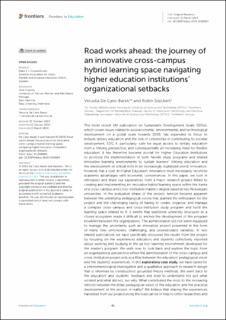| dc.description.abstract | The most recent UN publication on Sustainable Development Goals (SDGs), which covers issues related to socioeconomic, environmental, and technological development on a global scale towards 2030, has expanded its focus to include tertiary education and the role of Universities in contributing to societal development. SDG 4, particularly, calls for equal access to tertiary education from a lifelong perspective, and consequentially an increasing need for flexible education. It has therefore become pivotal for Higher Education Institutions to promote the implementation of both flexible study programs and related innovative learning environments to sustain learners’ lifelong education and the development of critical skills in an increasingly digitalized world. Innovation, however, has a cost. In Higher Education, innovation must necessarily reconcile academic advantages with economic conveniences. In this paper, we look in retrospect and share our experiences from a major research project linked to creating and implementing an innovative hybrid learning space within the frame of a cross-campus and cross-institution master’s degree based at two Norwegian universities. In the evaluation phase of the project, tension became apparent between the underlying pedagogical visions that sparked the enthusiasm for the project and the challenging reality of having to create, organize, and manage a complex cross-campus and cross-institution study program and build the learning space related to it. It seems that traditional university structures as a closed ecosystem made it difficult to anchor the development of the program in/within/between the organizations. The administration did not seem equipped to manage the uncertainty such an innovative project presented in the form of many new unforeseen, challenging, and unpredictable variables. In two related publications we have specifically discussed the results from the project by focusing on the experiences educators and students collectively reported about working and studying in the ad hoc learning environment developed for the master’s program. We wish now to look back and explore the topic from an organizational perspective where the administration of the cross-campus and cross-institution project acts as a filter between the educators’ pedagogical vision and the students’ experiences. In this exploratory case study, we have opted for a phenomenological investigation and a qualitative approach to research design that is informed by constructivist grounded theory methods. We went back to the educators’ and students’ feedback and tried to understand not just what worked and what did not, but why. What contributed the most to the increasing tension between the initial pedagogical vision of the educators and the practical development of the project in reality? We believe that sharing the experiences harvested from our project along the road can be of help to other researchers and stakeholders in confronting and finding solutions to the challenges that complex innovative projects might constitute for higher education institutions. | en_US |

